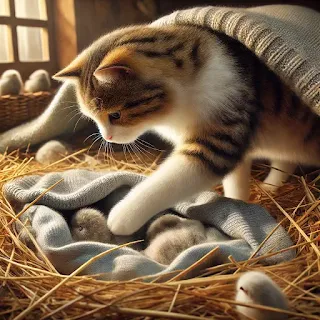The Curious Case of Pseudo-pregnancy
Ever had your pooch suddenly start nesting with stuffed toys, insisting on "cuddling" them as if they were newborns? Welcome to the wily world of pseudo-pregnancy - a hormonal masquerade that can make even the most rational pet behave like a doting, albeit confused, parent. While this phenomenon is most famously seen in dogs, it isn’t exclusive to our four-legged best friends. Today, we’re diving into the ins and outs of pseudo-pregnancy - not only in dogs but also in cats, rabbits, and other domestic critters. Buckle up for a journey through hormonal hijinks, diagnostic dilemmas, and practical prevention strategies.
What
Is Pseudo-pregnancy?
As discussed earlier, pseudo-pregnancy - also
called false pregnancy or phantom pregnancy - it's a physiological state in which
a non-pregnant
animal exhibits signs of pregnancy.
Why Does Pseudo-pregnancy Occur in Pets (Dogs and Cats)?
The reproductive cycle is orchestrated by a
delicate balance of hormones. Pseudo-pregnancy occurs when this hormonal
harmony goes off track,
leading an animal to exhibit pregnancy-like signs despite not being pregnant.
Dogs: The Phantom Puppy Parade
Imagine your dog as the star of her very own soap opera - a dramatic tale of hormones tricking her body into believing she’s about to become a mom, even when there’s no litter in the pipeline.
The Hormonal Drama Unfolds:
- Progesterone
Takes the Stage: Right after ovulation, your dog's body starts
pumping out progesterone. Think of it as the lead actress setting the scene for
a potential puppy blockbuster. Whether or not actual puppies are on the way,
progesterone is on cue, keeping her body in a “pre-puppy” mode for about 60
days .
- The Plot Twist - Progesterone’s Exit: If no pregnancy occurs, the progesterone eventually takes a dramatic bow and its levels drop off. This drop is like the director calling “Cut!” on the pregnancy scene.
- Enter Prolactin, the Uninvited Co-Star: With progesterone out of the picture, prolactin swoops in to steal the spotlight. Prolactin is the hormone that kick-starts milk production and gets your dog in full-on maternal mode. Suddenly, she starts showing classic signs of motherhood - nesting, nurturing her toys as if they were pups, and even producing milk. It’s as if her body is throwing an elaborate baby shower for a bunch of imaginary puppies.
Hormonal Breakdown:
- Normal Cycle:
- Pseudo-pregnancy (Abnormal):
Cats: The Feline Faux Pas
Imagine your cat as a drama queen with impeccable timing. Normally, she only ovulates when she mates (induced ovulation). However, in some cases - whether due to a sterile mating or extra stimulation - her body enters a pregnancy rehearsal mode:
How It Ha ppens:
- Date Night → Ovulation → “Pregnancy Rehearsal” : Her ovaries form a corpus luteum, producing progesterone for about 37 days.
- Progesterone Party → Faux Baby Shower : Her body starts acting pregnant, despite no kittens being on the way.
- Curtain Call → Back to
Normal : Once the progesterone levels drop as the corpus
luteum fades away, her faux-pregnancy act is over, and she returns to her
regular cycle, ready for the next real or accidental date. Its nature’s way of keeping things efficient - she can quickly bounce back and
try again when the real deal comes along.
- Normal Cycle:
- Pseudo-pregnancy (Rare in Cats):
Rabbits and Other Pets
Rabbits:
Other Species:
Why Do Dogs Experience Pseudo-pregnancy More Often?
Dogs are the undisputed champions of pseudo-pregnancy
due to their reproductive cycle:
- Prolonged Luteal Phase: After estrus, dogs maintain high progesterone levels for weeks, even if no pregnancy occurs. The eventual drop in progesterone and rise in prolactin makes them highly prone to pseudo-pregnancy.
- Pronounced Maternal Behaviors: Dogs often exhibit strong nesting instincts, making false pregnancies more noticeable than in other species.
In contrast, cats and rabbits
naturally reset their cycles
quickly, avoiding the prolonged hormonal imbalance that leads
to pseudo-pregnancy.
Recognizing the Signs: Real vs. Phantom Pregnancy
While pseudopregnancy can pop up in various domestic animals, dogs are particularly notorious for it. Here’s what you might observe in a pseudo pregnant pooch:
- Behavioral Clues: Both conditions may feature nesting and maternal behaviors, along with mammary gland enlargement and milk production but pseudo-pregnancy lacks significant abdominal enlargement since there is no growing litter to cause distension.
- Physical Signs: In true pregnancy, you’ll notice gradual, consistent weight gain, while pseudo-pregnancy may only cause mild swelling and lactation.
- Duration: In Dogs, Pseudo-pregnancy lasts 2-6 weeks, compared to the 63-day gestation period of a real pregnancy. while for Cats & Rabbits, Pseudo-pregnancy is typically short-lived (1-3 weeks) compared to normal gestation (63-65 days in cats, ~31 days in rabbits).
- Diagnostic Tools: Ultrasound - Confirms pregnancy (or lack thereof). Hormone Testing - Tracks progesterone and prolactin levels for confirmation.
What Can Owners and Vets Do?
- At
Home: Management Strategies
- Monitor Behavior
- Keep a close eye on changes in behavior, appetite,
and physical appearance following a heat cycle.
- Provide Comfort
- If your pet is displaying signs of distress,
ensure a calm environment. Offer extra attention and mental enrichment to
reduce anxiety.
- Adjust Diet
- Monitor food intake carefully - some pets may
overindulge while others might lose their appetite.
- Track Cycles
- Maintaining a detailed reproductive records can help
predict and manage future episodes.
In the Clinic: Veterinary Interventions
- Medications - Dopamine agonists can reduce prolactin and alleviate symptoms.
- Spaying (Ovariohysterectomy) - The only permanent solution to prevent recurrence, but timing is key - spaying during pseudo-pregnancy or the luteal phase can worsen symptoms due to a sudden prolactin surge.
Pseudo-pregnancy Recurrence Rates
- Dogs: Often recurs after every estrus cycle unless they are bred or spayed. Some dogs experience more intense episodes over time.
- Cats & Rabbits: Rarely experience recurring pseudo-pregnancy, as their reproductive cycles reset more efficiently.
Solution?
Spaying remains the
best way to prevent repeated episodes and long-term
complications like mastitis and behavioral distress.
Embracing Nature’s Hormonal Drama
Pseudo-pregnancy is a fascinating quirk of
nature, offering a glimpse into the complex
hormonal symphony that governs animal behavior. For pet owners,
understanding this condition means being better
prepared to support their furry (or hoppy) companions.
With vigilant
observation, veterinary care, and preventive strategies - whether
offering comfort at home or opting for spaying - you and your pet can navigate
this hormonal drama with confidence.
Have you ever experienced pseudo-pregnancy
in your pet? Share your stories in the comments below!
Check out previous post - Pseudo Pregnancy: The Great Expectation (That Wasn’t)






interesting
ReplyDelete